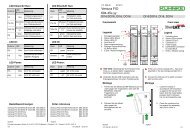PC Control / Profi Control 645-12M Instruction Manual pdf - Kuhnke
PC Control / Profi Control 645-12M Instruction Manual pdf - Kuhnke
PC Control / Profi Control 645-12M Instruction Manual pdf - Kuhnke
Create successful ePaper yourself
Turn your PDF publications into a flip-book with our unique Google optimized e-Paper software.
4.5.1.1. Short description of local operands<br />
<strong>PC</strong> <strong>Control</strong> <strong>645</strong>-<strong>12M</strong> used as PLC<br />
Operands are all addresses that can be addressed by the<br />
user program for signal processing or data storage. They<br />
are "operated" with.<br />
Inputs and outputs<br />
You can connect no local inputs and outputs to <strong>PC</strong> <strong>Control</strong><br />
<strong>645</strong>-<strong>12M</strong>. You can, however, use these addresses as additional<br />
markers.<br />
Bit, byte, word markers<br />
There are bit markers, byte markers (8 bit) and word markers<br />
(16 bit) available for storing (marking) current data.<br />
The contents (values) of remanent markers are not changed<br />
by RESET or restart. All other markers are cleared at restart.<br />
Timers<br />
<strong>PC</strong> <strong>Control</strong> <strong>645</strong>-<strong>12M</strong> has, as a standard, 128 software timers<br />
(PT00.00-PT07.15). The time range is from 10 ms -<br />
65535 s. These timers can be programmed with raising or<br />
falling delay or as clock pulse or pulse generators respectively.<br />
If required they can be remanent.<br />
Counters<br />
32 counters with a depth of 16 bit (0-65535) can be programmed<br />
as up or down counters. They too can be<br />
remanent if required.<br />
DP-RAM markers<br />
Address ranges SLG and SLH are used as process chart<br />
memory for data exchange processes between <strong>PC</strong> and<br />
PLC, e.g. for process visualisation. They are used in combination<br />
with KUBES module PA_MOVE.<br />
System error marker "ERR00.00"<br />
Once system errors have been detected, they are written<br />
into byte operand (8 bit) "ERR00.00" by the monitor program.<br />
They can be read and analysed by the user program.<br />
4 - 17









